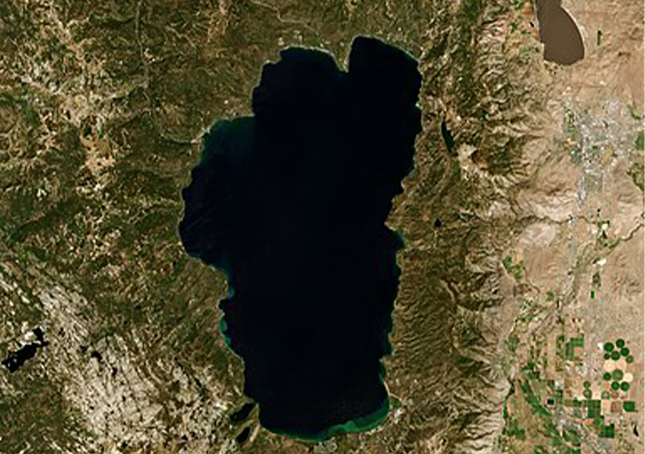Lake Tahoe

Lake Tahoe (/ˈtɑːhoʊ/; Washo: dáʔaw, ‘the lake’) is a large freshwater lake in the Sierra Nevada of the United States. Lying at 6,225 ft (1,897 m), it straddles the state line between California and Nevada, west of Carson City. Lake Tahoe is the largest alpine lake in North America,[4] and at 122,160,280 acre⋅ft (150.7 km3) it trails only the five Great Lakes as the largest by volume in the United States. Its depth is 1,645 ft (501 m), making it the second deepest in the United States after Crater Lake in Oregon (1,949 ft or 594 m).[1]
The lake was formed about two million years ago as part of the Lake Tahoe Basin, and its modern extent was shaped during the ice ages. It is known for the clarity of its water and the panorama of surrounding mountains on all sides.[5] The area surrounding the lake is also referred to as Lake Tahoe, or simply Tahoe. More than 75% of the lake’s watershed is national forest land, being the Lake Tahoe Basin Management Unit of the United States Forest Service.
Lake Tahoe is a major tourist attraction in both Nevada and California. It is home to winter sports, summer outdoor recreation, and scenery enjoyed throughout the year. Snow and ski resorts are a significant part of the area’s economy and reputation.[6][7] The Nevada side also offers several lakeside casino resorts, with highways providing year-round access to the entire area.
The English name for Lake Tahoe derives from the Washo word “dá’aw,” meaning “The Lake.”
Lake Tahoe is the second deepest lake in the U.S., with a maximum depth of 1,645 feet (501 m),[1][9] trailing Oregon’s Crater Lake at 1,949 ft (594 m).[9] Tahoe is the 16th[10] deepest lake in the world, and the fifth deepest in average depth. It is about 22 mi (35 km) long and 12 mi (19 km) wide and has 72 mi (116 km) of shoreline and a surface area of 191 square miles (490 km2). The lake is so large that its surface is noticeably convex due to the curvature of the earth. At lake level the opposing shorelines are below the horizon at its widest parts; by nearly 100 feet (30 m) at its maximum width, and by some 320 feet (98 m) along its length.
Visibility may vary somewhat with atmospheric refraction;[13] when the air temperature is much greater than the lake temperature, looming may occur where the lake surface or opposing shoreline is lifted above the horizon. Fata Morgana may be responsible for Tahoe Tessie sightings.
Lake Tahoe is fed by 63 tributaries. These drain an area about the same size as the lake and produce half its water, the other half by direct precipitation.
